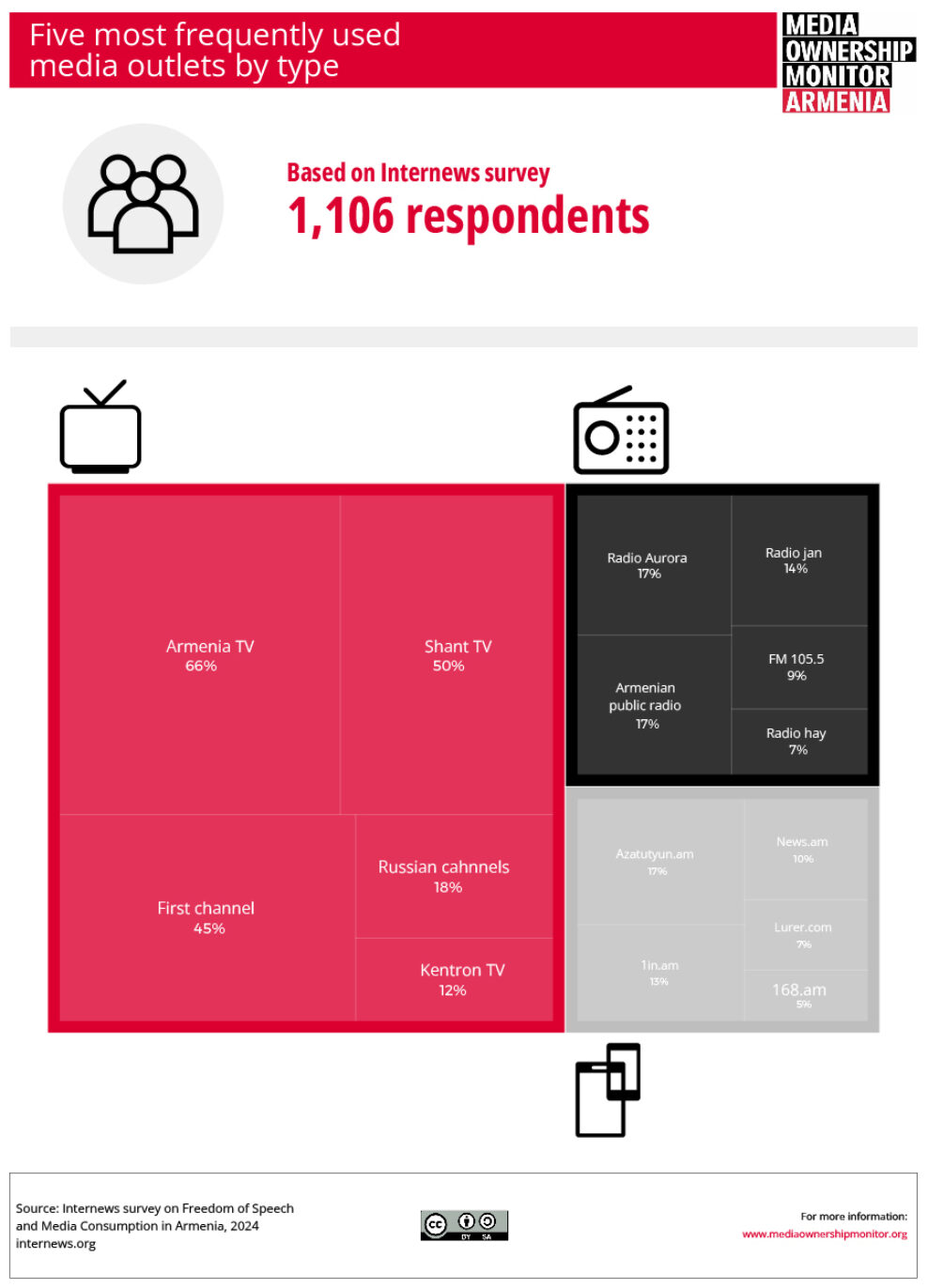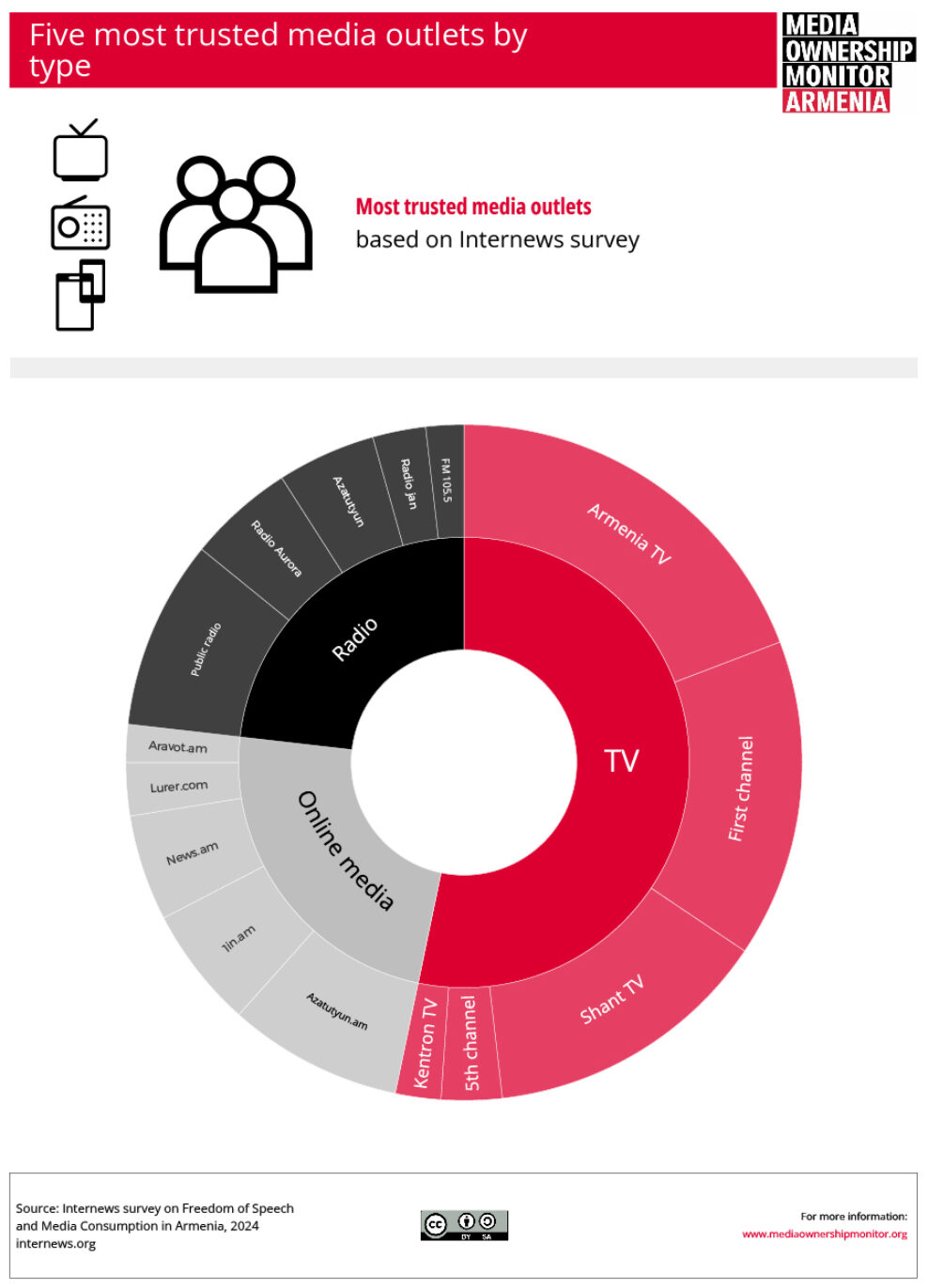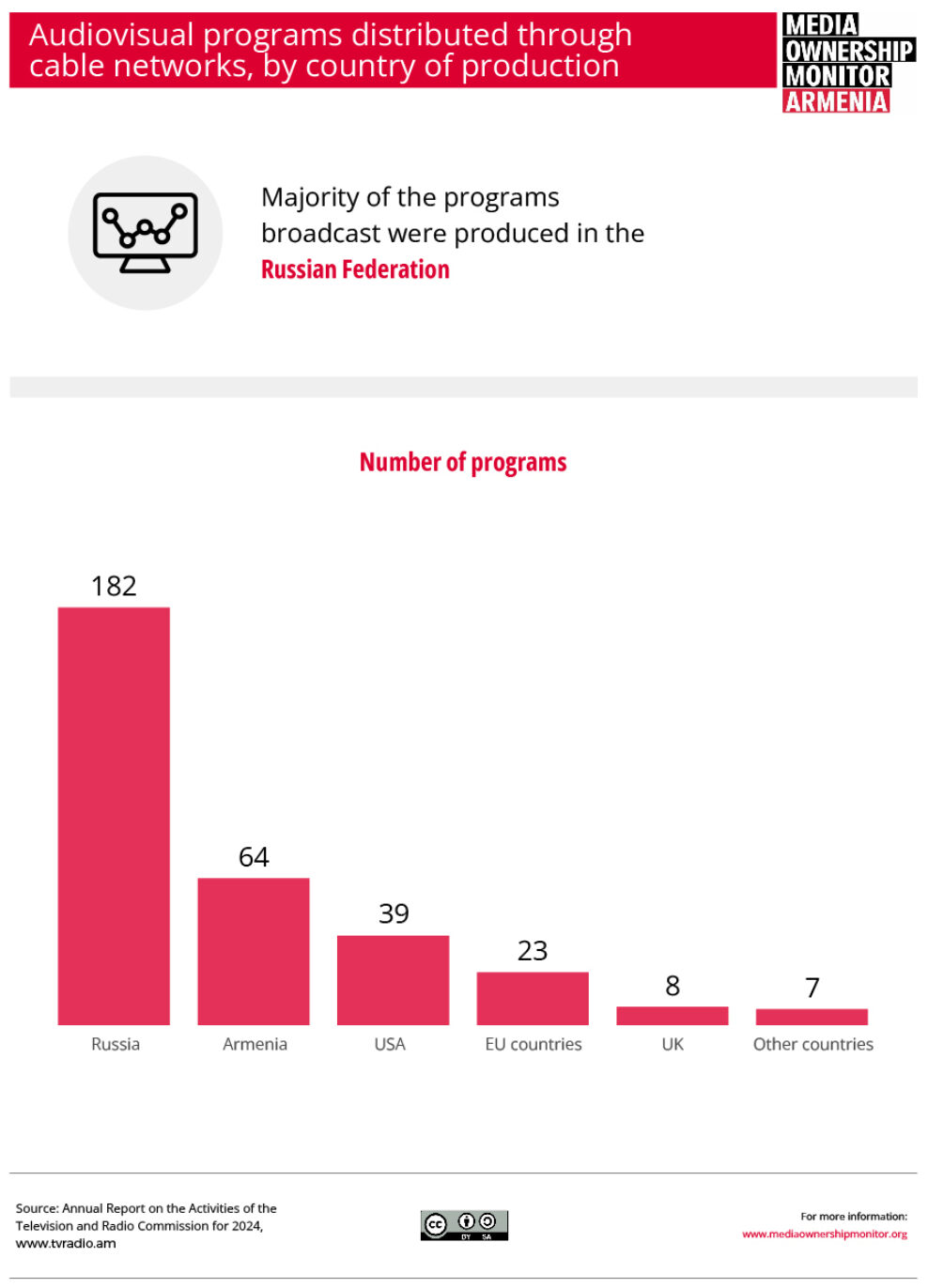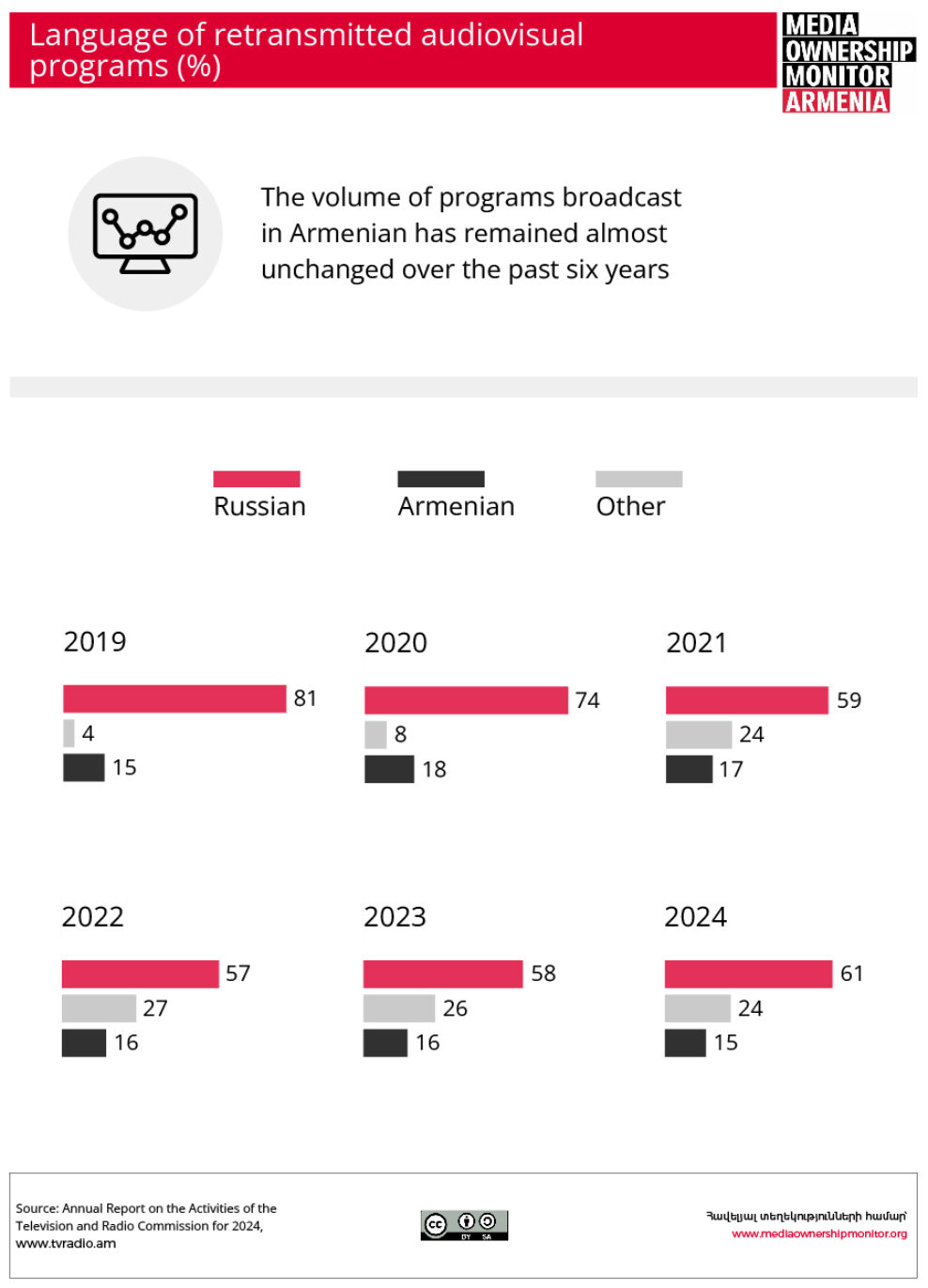Media Consumption in Armenia
Understanding how Armenians access and consume media provides essential context for evaluating media ownership, influence, and the information environment in which outlets operate. This section presents baseline data on media consumption patterns, showing both continuity with historical trends and significant shifts driven by digital transformation.
Overview: Media Access and Infrastructure
Media has widespread reach in Armenia and is accessible to much of the population through various technologies. According to data from Armenia’s Statistical Committee, as of 2023 television remained the primary source of information, with accessibility reaching 98.6%, while the use of digital and satellite channels continued to grow. Radio remained an important source of information, particularly in the provinces and among older segments of the population.
Digital Access: Internet, Mobile, and Social Media
Internet and Mobile Connectivity
According to the Digital Armenia 2025 report, the number of internet users in 2025 reached 2.37 million (those who have ever used the internet), representing approximately 80% of the population.The number of mobile connections in 2025 is 4.35 million, representing 147% of the population. This indicates that people use more than one SIM card. A sizable portion of mobile connections (96.7%) are 3G/4G/5G.
Social Media Platforms
The total number of social media users in 2025 is 1.6 million, representing approximately 54% of the population. Platform-specific usage breaks down as follows:
- Facebook: approximately 54% of the population over thirteen years old
- Instagram: approximately 1.3 million users, 43.9% of the population over thirteen years old
- Messenger: more than 1.15 million users, 39.1% of the population over thirteen years old
- LinkedIn: 480,000 users, approximately 16.2% of the population over eighteen years old
- X (formerly Twitter): approximately 4.6% of the population over thirteen years old, or 135,000 people
- YouTube: exact numbers unavailable, but expert estimates place this platform in a leading position in Armenia
These figures demonstrate the significant role digital platforms play as to how Armenians access information, with implications for how traditional media ownership affects public discourse as gatekeeping functions shift to social networks.
Media Consumption Patterns
Internews Network's 2024 research on freedom of speech and media consumption in Armenia reveals how Armenians access news and information across different platforms. Traditional television and online news websites remain the most used media outlets, accessed by 80% and 73% of respondents, respectively. However, consumption patterns show generational differences and platform shifts.For social and political news specifically:
- 62% of respondents rely on social networks
- 45% rely on television
- 3% use radio
- 0.5% use print media
The research notes: "The overall analysis of media consumption patterns in Armenia reveals a stable but evolving media landscape. People increasingly rely on online sources, particularly social networks, to receive and disseminate news. Seven out of ten individuals prefer to receive news through social networks rather than directly visiting websites. Although Facebook remains the leading platform for news distribution, its use has declined. Instagram is gaining wider adoption as an alternative to Facebook."
Most Consumed Media Outlets

Print Media Consumption
Print media consumption rates remain quite low. Fifteen percent of respondents stated they read at least one print publication weekly. The most frequently mentioned were:
- TV Alik weekly newspaper: 9% (an entertainment newspaper that also prints weekly television programs)
- Hraparak: 6%
- Aravot: 6%
Trust in Media Outlets
Trust levels often differ from consumption patterns, with some widely-consumed outlets receiving lower trust ratings.

Traditional Broadcast Media Infrastructure
Television
According to the Television and Radio Commission, as of 2025, there are twenty-eight television companies (audiovisual programs) operating in Armenia. Of these, twenty-one are licensed broadcasters: five with nationwide coverage, six with capital city coverage, and ten with regional coverage. Three channels operate as public broadcasters without requiring licenses: First Channel, First Channel News, and Shoghakat, which are operated by Public Television Company of Armenia CJSC and Spiritual-Cultural Public Television Company CJSC. The remaining four channels are foreign or interstate broadcasters that operate under interstate agreements rather than Armenian licenses.
Radio
As of 2025, twenty-seven private radio stations operate based on licenses issued by the Television and Radio Commission. Of these, three broadcast throughout the republic, fifteen only in Yerevan, eight only in the provinces, and one in Yerevan and Gegharkunik province.The public broadcaster, Public Radio Company of Armenia CJSC, operates 4 channels without requiring licenses: the nationwide First Program and three capital city programs including My Radio, VEM educational-cultural program, and Arevik children's program. Additionally, two radio programs broadcast based on interstate agreements with foreign or interstate radio channels.
Foreign Media Influence
Based on interstate agreements, several foreign television and radio companies broadcast in Armenia without requiring Armenian licenses. This represents a significant structural element of Armenia's media environment.
Russian Broadcasting
The 2020 Agreement on Cooperation in the Field of Mass Communications between the Government of the Republic of Armenia and the Government of the Russian Federation provides for broadcasting of:
- RTR-PLANETA (nationwide coverage)
- ROSSIYA-K (capital city coverage)
- FIRST CHANNEL. WORLD NETWORK (capital city coverage)
In recent years, Armenia’s Television and Radio Commission has repeatedly raised concerns about terminating the broadcasting of these channels in Armenia, accusing them of disseminating "offensive expressions addressed to Armenian state institutions and citizens, distorted assessments, and emotional and aggressive characterizations instead of facts." However, Armenian authorities have not yet made such a decision.
Other Interstate Broadcasting
Also broadcasting based on interstate agreements:
- MIR television channel and radio (in Russian): Operated by the Armenian national branch of the MIR Interstate Television and Radio Company, receiving funding from the state budget of the Republic of Armenia
- RFI (Radio France Internationale): French radio station whose broadcasting is supported by the French Embassy in Armenia
Cable and Network Distribution
In addition to the public multiplex, audiovisual programs in Armenia are distributed through cable or other networks via network operators. According to the Television and Radio Commission's 2024 annual report, as of December 31, 2024, sixty-one network operators were operating in the Republic of Armenia:
- Twelve operated throughout the Republic of Armenia
- Ten in Yerevan city and one or more provinces
- Six in Yerevan only
- Two in more than one province
- Thirty-one in one province
Content by Country of Origin

Among programs distributed on cable networks, content produced in Russia predominated. This predominance of Russian-language content reflects both historical ties and ongoing media infrastructure dependencies.
Programs broadcast in Russian predominated among retransmitted audiovisual programs. The following table shows the comparative picture of broadcasting languages from 2019-2024:

While Russian-language content declined significantly from 2019 to 2022, it increased again in 2023-2024, consistently comprising more than half of all retransmitted content.
Print and Online Media: Registration Gaps
Armenia does not have any comprehensive registry for the registration and accounting of media outlets. Since broadcasting is a licensed activity, information about television and radio companies is provided by the regulatory body, the Television and Radio Commission. No one, however, collects such comprehensive information about online and print media.
Print Media Registration
Like any legal entity, media outlets are registered in the State Register of Legal Entities of the Ministry of Justice, but it is not possible to distinguish media outlets from this register by type of activity. According to Article 13 of the Law on Mass Media, the State Register of Legal Entities Agency registers media outlets issued on physical media and distributed in the Republic of Armenia, based on mandatory copies received and publication data.
"As of September 12, 2025, the number of press and other mass media outlets issued on physical media and registered by the State Register of Legal Entities Agency of the Ministry of Justice of the Republic of Armenia is 2,153," according to the agency.
However, this list contains names of print periodicals that have long ceased to exist. According to the agency's clarification, if a media outlet does not notify them about ceasing operations, they do not remove it from the list. The agency estimates that 5-7% of these 2,153 do not currently operate.
Online Media Registration
The function of registering online media outlets is not reserved by law to the State Register Agency, therefore such registration is not conducted. This regulatory gap is significant because online media outlets now reach substantial audiences but operate without the licensing requirements, oversight, or public accountability mechanisms that apply to broadcast media.
In practice, it is difficult to state precisely how many online or print media outlets exist in Armenia.
Response of the Statistical Committee of Armenia to Hetq's inquiry, 25.09.2025

